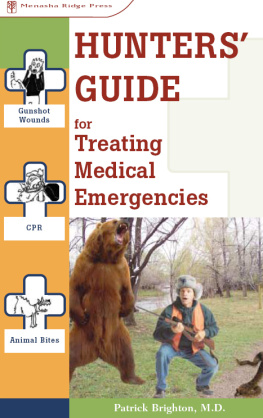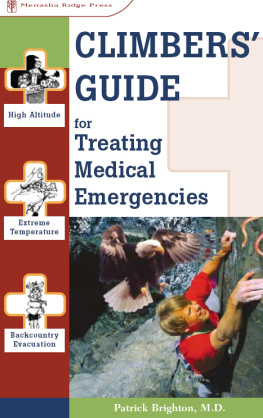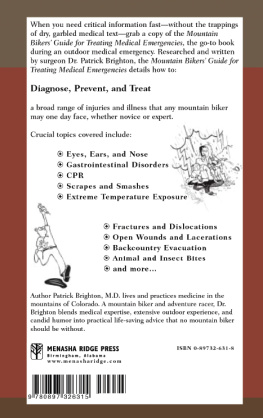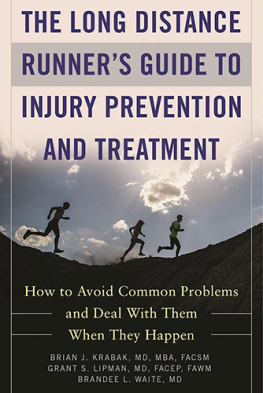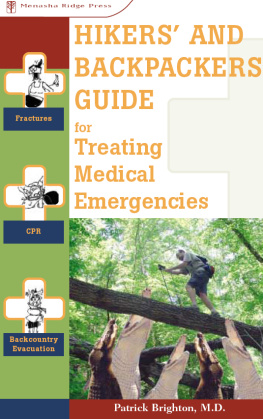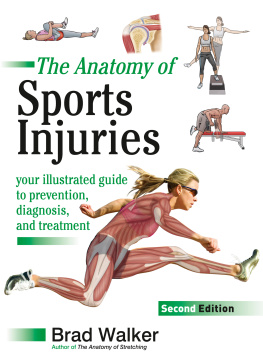
Copyright 2006 Patrick Brighton
All rights reserved
Printed in the United States of America
Published by Menasha Ridge Press
Distributed by Publishers Group West
First edition, first printing
Library of Congress Cataloging-in-Publication Data
Brighton, Patrick, 1962
Hunters guide for treating medical emergencies / Patrick Brighton.1st ed.
p. cm.
ISBN 978-0-89732-628-5
1. Hunting accidents. 2. First aid in illness and injury. 3. Medical emergencies. I. Title.
RC88.9.H86B75 2005
616.025dc22
2005049633
Illustrations by Tami Knight
Text design by Clare Minges
Cover design by Travis Bryant
Menasha Ridge Press
P.O. Box 43673
Birmingham, AL 35243
www.menasharidge.com
ACKNOWLEDGMENTS
Dont you love it when the Academy Award winners launch into a 30-minute sermon in which they thank everyone from the person who cuts the hair around their poodles butt to Aunt Marthas financial advisor?
There are, however, a number of people who made this work possible, so if you enjoy any portion of it, send your thanks to them. Firstly, Bob Sehlinger at Menasha Ridge Press, who called me out of the blue and said, Why dont you get off your tokhes and do something constructive? Thats paraphrased, by the way. Also, I thank Russell Helms, Molly Merkle, and the rest of the wonderful Menasha Ridge staff. Next, Tami Knight, who has been kind enough to share with us her unsurpassed wit and insight through her illustrations.
Finally, I would like to say thank you to the person who has been my constant companion for the last ten years and who has truly shown me what it means to be able to enjoy a peaceful, balanced lifemy dear wife, Kimberley.
INTRODUCTION
SCENE: The sun is setting; father and son (age nine) dove-hunting in the New Mexico wilderness
Boy: Dad, I think my shotguns jammed.
Dad: Is there a shell in the chamber?
Boy: I dont think so.
Dad takes shotgun from boy, points muzzle in safe direction, and starts working to unjam the action.
Shotgun: Booomm!!!
Dad: No shell in the chamber, huh?
Boy: Sorry, Dad (thinking to himself, Sorry I almost got both our heads blown off.).
Dad: (thinking to himself, Did I really donate good sperm to create this nimrod?)
OK, the boy was me, and was my dad pissed (rightly so). That episode left an indelible impression on me and drove home two critical points regarding firearm safety: (1) always treat a gun as if it is loaded, and (2) never point the muzzle (even for a millisecond) at anything that you dont want to kill. That means that if you wave the muzzle past your child (or other loved one), even inadvertently, you had better be prepared to kill that person. Seems a little harsh, but given the astronomical number of accidental shootings, it may not be nearly harsh enough.
Why is this so important in a medical text? Firearm injuries (and those from arrows, for that matter) are so devastating (think: lethal) that prevention is the absolute top concernprevention being far more effective at ensuring ones health than field treatment.
This book will cover most of the common medical emergencies a hunter is likely to face in the backcountry, but among the most lethal and difficult to treat are firearm and projectile injuries. So, even if taking a hunter-safety course is not a prerequisite for getting a hunting license in your state, I implore you to take a class before venturing into the wild with your semiautomatic meat-bagger.
OK, safety lecture overfor now. On to hunting! I will have to say that hunting, and especially hunting with your child, can be one of the most satisfying, bonding experiences in this life (I feel like Dr. Ruth). Just dont mistake Grandpa for a wild boar, and be safe!
MEDICATIONS
Dispensing
Medicationschemicals synthesized from raw materials ruthlessly extracted from our rapidly vanishing rain forests only to enhance our already pathetically easy existence wait a minute, wrong speech. Anyway, medications really are beneficialeven essential in certain emergencies outdoors. Most medications are administered orally ( per os, for you Latin speakers). However, certain medications can be administered only by injection, either into a muscle or vein, and still others are given via inhalation, through patches applied to the skin, or by insertion into the rectum (wait a minute, I dont think I know you that well). Most medicationsibuprofen, Claritin, and so onare given orally, and we are all familiar with taking medications this way. In a medical emergency, however, the victim may not be conscious, may have an obstructed airway, or may not be able to otherwise swallow medications. Do not ever attempt to give a victim medications by mouth under these circumstances, or if you have any concern that a pill may end up in his airway instead of his stomach.
ORAL As discussed above, you may give medications to a person who is awake and cooperative and has a clear airway. Remember, medications given by mouth require at least 30 minutes to take effect, so you would probably not give medications this way in a true emergency.
INJECTIONS This is the most expeditious method of delivering immediately available medications, but injections should be administered only by trained personnel. Improperly administering parenteral (injectable) medications can be much more lethal than not giving any medication. There are only a handful of injectable medications that one might potentially use, and these would typically be administered only in dire emergencies by trained rescue personnel.
INHALANTS Inhaled medications are usually those that a person takes routinely: asthma or allergy meds, for instance. Administering assistance with these medications usually involves helping a person find her steroid asthma inhaler.
PATCHES There is little reason to administer medications by patch in a medical emergency. The medication absorbs slowly and predictably, usually over 6 to 24 hourstoo much time to be of use in the short term.
SUPPOSITORIES This is actually an excellent way to administer some medications and to break the ice in certain hard-to-start relationships. As weird as it sounds, medications dissolve and are absorbed in the inside lining (mucosa) of the rectum quite efficiently. This is a handy way to get some drugs circulating in victims who are nauseated or are otherwise unable to take medications by mouth. Antinausea medications and Tylenol are the most commonly administered rectal medications. Regarding technique, you must make sure that (1) the medication and the (one hopes) gloved finger that is placing the suppository are well lubricated (with KY jelly, olive oil, water, etc.), and (2) the medication is positioned at least one to two inches inside the rectum. This will ensure that the medicine is within the confines of the rectum, where it can be absorbed.
Precautions
Here comes the cautionary advice. Please, please, please only carry medications that you personally are familiar with administering; you must completely understand the dosage as well as the possible side effects and potential interactions with other medications.
Disclaimer
And now for the legal portion of our program: All medicationsthats right all including Tylenol, ibuprofen, and even oxygen, can be lethal if administered inappropriately. The advice in this text represents what I would anticipate doing, having studied medicine and trained in this field for 20-odd years. As with most things in life, there are usually several ways to achieve a positive result in an emergency, so I recommend gathering as much information as you canbeginning with this bookand applying that information in a thoughtful manner compatible with the situation.
Next page
